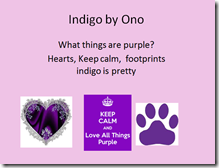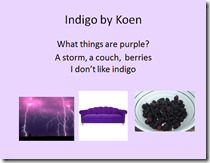We have just heard that our team has won the Global Virtual Classroom website design competition!!
What competition , you say? Well, my Grade 5 ICT class and I entered the six-month
Global Virtual Classroom International website design competition, primary school division, in September last year, where entrants were partnered with two other schools in other countries. (We started when the students were still in Grade 4) The newly-created three-school team had to collaborate on a project of their own choosing and upload their findings to a Google site. We were placed with a great team – a Grade 6 class from a primary school in Illinois, USA and two Grade 5 classes from a primary school in Taiwan.
There was much excitement yesterday when the winners were announced and we heard that
we had won the primary school category. So exciting! Our winning site -
Recycling to Live Green. Here is the competition coordinator's message to tell us of our win.
“Congratulations! After the final round of judging, your website has been selected as the Grand Prize Winner in the primary school category! Each school will be mailed a plaque. By email you will also receive a copy of this Award that can be printed for students. Also by email you will receive a printable PDF of the Sponsorship/ Scholarship made in your name to continue the education of a needy student.
This team’s collaboration is an example of how the program should be run. The energy of the team was apparent. It was a pleasure to work with all of you and your students are privileged to have you as teachers. The example and the experience you have provided with them is truly a life lesson.
Once again, thank you for your desire to immerse your students in a collaborative environment. Your students, schools and communities have all benefitted.
I have included at the end of the message, comments from the judges so you and your students have the benefit of their feedback.”
Judges comments:
GVC1402-Recycling to Live Green
https://sites.google.com/a/gsbi.org/gvc1402/
USA – South Africa - Taiwan
“Fantastic web design! Pages have lots of content and great images, but are easy to read and enjoyable to explore. Great use of colors reflects theme and feels natural.”
“Great videos. There was consistent citation throughout the site. Lots of good tips in “My Eco Diary”. I had never thought of recycling in terms of saving space, such as the tips for plastic bags, plastic bottles and cartons.”
“Great site with useful information. The helping focus is directly connected to the topic. Navigation is logical.”
“This was a very thought provoking and informative website. I loved the opening video – very impactful! Impossible – Possible!!! The videos were great. I appreciated your wonderful helping focus projects. Great work!”
“Impressive content, nice use of research to support web content, excellent works cited, nice collaborative efforts.”
“Well organized and documented, with excellent credits. Loved the trashion fashion show!”
What was the competition about?
The GVC Contest, a multi-national team website design contest, provides an opportunity for primary and secondary school students from different countries to work and learn from students in other countries, as they collaboratively design a website on a topic of their choosing. Plaques and cash awards are presented to the schools of the winning teams and each student receives a certificate of participation. The competition has been running since 2005. Previous winning sites can be see at this link:
http://www.virtualclassroom.org/win13.html
As mentioned, we entered and were placed in a group of three schools. What a fantastic team we had – a school in Taiwan, a school in Illinois, USA and ourselves. We learned so much from our partner schools.
What did we learn in this competition?
1. We saw the value of global collaboration – that the world is indeed a global village and that real world learning that takes place with others in different parts of the world is engaging and fun.
2. We saw that Google Sites is a great project platform - easy to use but very effective as a website. We used many other Google tools in this project – Google Docs, Google Slides, Gmail, Google Forms, YouTube, etc.
3. We learned the value of working with group roles. The students had to do the creation of and uploading to the Google site, and specific students in each of the three countries were tasked with this.
4. We learned about copyright and plagiarism and citing our work and the work of others online.
5. We used Skype for team communication and Edmodo to keep in touch with the project happenings.
6. As a result of this competition we are in touch with an amazing global community of teachers on Skype called
HLWSkypers (Hello Little World Skypers) co-ordinated by Janet Barnstable from the UK who is also the GVC project competition co-ordinator.
Thank you, GVC, for this opportunity!
Why don't YOU think about entering in September this year?
The next round of the competition will start in September 2015. Keep watching the Global Virtual Classroom website for details
http://virtualclassroom.org/. The learning benefits will be enormous for both you and your class.




![[image7.png]](https://blogger.googleusercontent.com/img/b/R29vZ2xl/AVvXsEjvryhFxQK1qDzAPEaBKmHmwEVzws33XNwnjJtW5_hzY18leDGmi1J_co5CaVd9xkw1UI_ZAHmbu1D2VPGuoxTCLczoyZuvrz6WmEAH2jbHBDW2CjhpDu8B6BfZDGCjT_I-6-9s9SO2aCk/s1600/image7.png)
 With the Grade 2-5s I thought we should use Microsoft Publisher and then save each postcard as a PDF. (We could just as easily used Microsoft Word!) With the Grade 2s and 3s I created the template for them. Hopefully we could complete the lesson in one 45 minute period. The idea is to have the back and the front of the postcard on the same A4 page:
With the Grade 2-5s I thought we should use Microsoft Publisher and then save each postcard as a PDF. (We could just as easily used Microsoft Word!) With the Grade 2s and 3s I created the template for them. Hopefully we could complete the lesson in one 45 minute period. The idea is to have the back and the front of the postcard on the same A4 page:


































